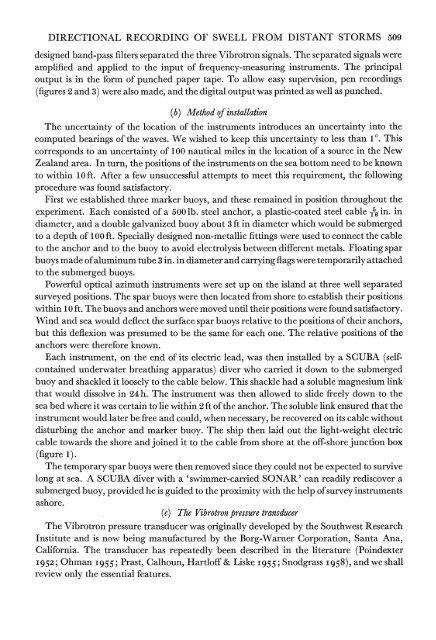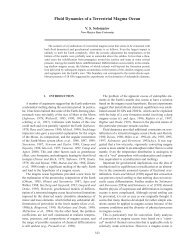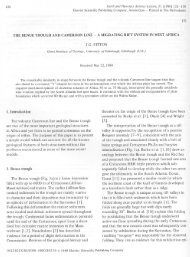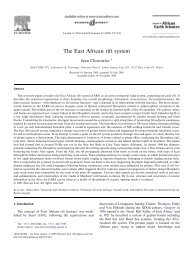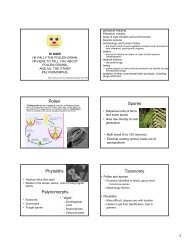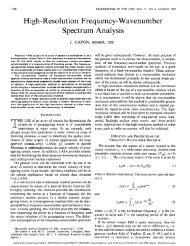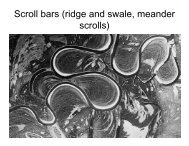Directional Recording of Swell from Distant Storms - Department of ...
Directional Recording of Swell from Distant Storms - Department of ...
Directional Recording of Swell from Distant Storms - Department of ...
You also want an ePaper? Increase the reach of your titles
YUMPU automatically turns print PDFs into web optimized ePapers that Google loves.
DIRECTIONAL RECORDING OF SWELL FROM DISTANT STORMS 509designed band-pass filters separated the three Vibrotron signals. The separated signals wereamplified and applied to the input <strong>of</strong> frequency-measuring instruments. The principaloutput is in the form <strong>of</strong> punched paper tape. To allow easy supervision, pen recordings(figures 2 and 3) were also made, and the digital output was printed as well as punched.(b) Method <strong>of</strong> installationThe uncertainty <strong>of</strong> the location <strong>of</strong> the instruments introduces an uncertainty into thecomputed bearings <strong>of</strong> the waves. We wished to keep this uncertainty to less than 1?. Thiscorresponds to an uncertainty <strong>of</strong> 100 nautical miles in the location <strong>of</strong> a source in the NewZealand area. In turn, the positions <strong>of</strong> the instruments on the sea bottom need to be knownto within 1Oft. After a few unsuccessful attempts to meet this requirement, the followingprocedure was found satisfactory.First we established three marker buoys, and these remained in position throughout theexperiment. Each consisted <strong>of</strong> a 500 lb. steel anchor, a plastic-coated steel cable 156 in. indiameter, and a double galvanized buoy about 3 ft in diameter which would be submergedto a depth <strong>of</strong> 100 ft. Specially designed non-metallic fittings were used to connect the cableto the anchor and to the buoy to avoid electrolysis between different metals. Floating sparbuoys made <strong>of</strong> aluminum tube 3 in. in diameter and carrying flags were temporarily attachedto the submerged buoys.Powerful optical azimuth instruments were set up on the island at three well separatedsurveyed positions. The spar buoys were then located <strong>from</strong> shore to establish their positionswithin 10 ft. The buoys and anchors were moved until their positions were found satisfactory.Wind and sea would deflect the surface spar buoys relative to the positions <strong>of</strong> their anchors,but this deflexion was presumed to be the same for each one. The relative positions <strong>of</strong> theanchors were therefore known.Each instrument, on the end <strong>of</strong> its electric lead, was then installed by a SCUBA (selfcontainedunderwater breathing apparatus) diver who carried it down to the submergedbuoy and shackled it loosely to the cable below. This shackle had a soluble magnesium linkthat would dissolve in 24h. The instrument was then allowed to slide freely down to thesea bed where it was certain to lie within 2 ft <strong>of</strong> the anchor. The soluble link ensured that theinstrument would later be free and could, when necessary, be recovered on its cable withoutdisturbing the anchor and marker buoy. The ship then laid out the light-weight electriccable towards the shore and joined it to the cable <strong>from</strong> shore at the <strong>of</strong>f-shore junction box(figure 1).The temporary spar buoys were then removed since they could not be expected to survivelong at sea. A SCUBA diver with a 'swimmer-carried SONAR' can readily rediscover asubmerged buoy, provided he is guided to the proximity with the help <strong>of</strong> survey instrumentsashore.(c) The Vibrotron pressure transducerThe Vibrotron pressure transducer was originally developed by the Southwest ResearchInstitute and is now being manufactured by the Borg-Warner Corporation, Santa Ana,California. The transducer has repeatedly been described in the literature (PoindexterI952; Ohman I955; Prast, Calhoun, Hartl<strong>of</strong>f & Liske I955; Snodgrass I958), and we shallreview only the essential features.


